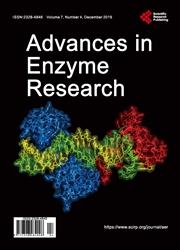Dexamethasone treatment alters kinetics properties of liver mitochondrial F 0 .F 1 -ATPase and membrane lipid profiles in developing and adult rats
引用次数: 3
Abstract
Dexamethasone—a potent synthetic glucocorticoid—has multiple diagnostic and therapeutic applications in wide range of age groups. However, the side-effects of dexamethasone (Dex) treatment including those on development are becoming increasingly apparent. Since the developmental processes are energy-dependent, we examined the effects of chronic Dex treatment on kinetics properties of liver mitochondrial F0.F1-ATPase and mitochondrial membrane lipid profiles in rats belonging to different developmental age groups (2, 3, 4 and 5 weeks) and in adults (~8 weeks). The animals were treated with a subcutaneous dose of 2 mg of Dex/kg body weight (or saline as vehicle) for three alternative days (at around 7.00 A.M.) prior to the day of sacrifice. Dex treatment resulted in significant reduction in F0.F1-ATPase activity in developmental age groups and in adults as compared to their age-matched vehicle-treated control group. The substrate kinetics analysis of F0.F1-ATPase resolved Km and Vmax values in 3 components in all the control age groups; whereas Dex treatment significantly altered the Km and Vmax values or abolished the entire components in age-specific manner. Dex treatment significantly lowered the energy of activation and altered phase transition temperature (TtoC) in all the developmental age groups and in adults. Dex treatment significantly increased the contents of total phospholipid (TPL), individual phospholipids classes and cholesterol (CHL) in all the developmental age groups whereas opposite pattern was observed in adults. The mitochondrial membrane became more fluidized in the developing age groups (2, 4 and 5 weeks); whereas no change was observed in 3-week and adult groups following Dex treatment. In present study, our data demonstrate comprehensive deleterious effects of chronic Dex treatment on liver mitochondrial membrane structure and F0.F1-ATPase functional properties with respect to energy metabolism. At the same time, our data also warns against excessive repeated use of antenatal DEX in treatments in growing and adult human patients.地塞米松治疗改变了发育和成年大鼠肝脏线粒体f0 . f1 - atp酶的动力学特性和膜脂谱
地塞米松是一种有效的合成糖皮质激素,在广泛的年龄组中具有多种诊断和治疗应用。然而,地塞米松(Dex)治疗的副作用,包括对发育的副作用正变得越来越明显。由于发育过程是能量依赖的,我们研究了慢性Dex治疗对肝脏线粒体F0动力学特性的影响。不同发育年龄组大鼠(2、3、4、5周龄)和成年大鼠(~8周龄)的f1 - atp酶和线粒体膜脂谱。动物在献祭日之前连续3天(上午7点左右)皮下注射2 mg /kg体重的Dex(或生理盐水作为对照品)。Dex治疗导致F0显著降低。发育年龄组和成人的f1 - atp酶活性与同龄车辆对照组比较。F0底物动力学分析。F1-ATPase对各对照组3个成分的Km和Vmax值均有分解作用;而右美托咪定显著改变了Km和Vmax值,或完全消除了各成分的年龄差异。右美托咪唑处理显著降低了所有发育年龄组和成人的激活能和相变温度(TtoC)的改变。Dex处理显著提高了各发育年龄组的总磷脂(TPL)、单个磷脂类和胆固醇(CHL)含量,而成人则相反。在发育中的年龄组(2、4和5周),线粒体膜变得更加流化;而在服用右美托咪定治疗后3周和成年组未见变化。在本研究中,我们的数据显示慢性右美托咪唑治疗对肝脏线粒体膜结构和F0的全面有害影响。f1 - atp酶在能量代谢方面的功能特性。与此同时,我们的数据也警告说,在生长和成年人类患者的治疗中,不要过度重复使用产前DEX。
本文章由计算机程序翻译,如有差异,请以英文原文为准。
求助全文
约1分钟内获得全文
求助全文

 求助内容:
求助内容: 应助结果提醒方式:
应助结果提醒方式:


